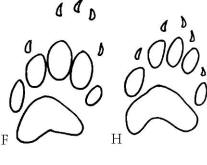Most damage caused by badgers results from their digging in pursuit of prey. Open burrows create a hazard to livestock and horseback riders. Badger diggings in crop fields may slow harvesting or cause damage to machinery. Digging can also damage earthen dams or dikes and irrigation canals, resulting in flooding and the loss of irrigation water. Diggings on the shoulders of roads can lead to erosion and the collapse of road surfaces. In late summer and fall, watch for signs of digging that indicate that young badgers have moved into the area.
Badgers will occasionally prey on livestock or poultry, gaining access to protected animals by digging under fences or through the floor of a poultry house. Tracks can indicate the presence of badgers, but to the novice, badger tracks may appear similar to coyote tracks (see Coyotes ). Claw marks are farther from the toe pad in badger tracks, however, and the front tracks have a pigeon-toed appearance (Fig. 3).
Badgers usually consume all of a prairie dog except the head and the fur along the back. This characteristic probably holds true for much of their prey; however, signs of digging near the remains of prey are the best evidence of predation by a badger. Because badgers will kill black-footed ferrets, their presence is of concern in reintroduction programs for this endangered species.
